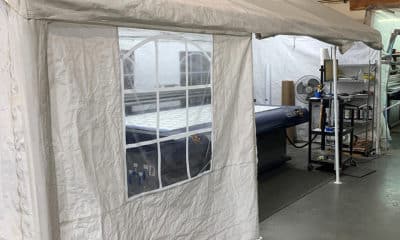DURING CLIENT SITE visits I encounter a variety of challenges, from matching color to optimizing workflow. However, one thing I see at almost every shop is a misconception about how much data is necessary for proper color sampling. Print technicians often select too many data points or not enough.
Consider per-channel ink limiting, where the goal is to cut as much ink as possible without reducing the color range, or color gamut. Sampling each primary color (CMYK) in small increments results in a lot of non-useful data. I’ve seen prints where more than half of the chart is the same color because of too many data samples. Determining how much ink to cut is easier with fewer color samples – say, 10-percent increments for per-color channel ink restriction.
Color linearization is similar. The default for some RIPs is to use a lot of data. And at face value, more data seems better, and sampling color at 3- or 5-percent increments (100 percent to 95, 90, etc.) provides a lot of data. However, sometimes more data does not improve accuracy. In fact, too much data can produce very rough curves. Using fewer points results in smoother correction curves, but at the cost of accuracy. In practice, you want more data points in some areas of the tonal scale and fewer data points in others.
One approach is to sample more in the highlights and less in the mid-tones and shadows. Reduced sampling in the mid-tones and shadows results in a smoother curve. Meanwhile, extra sampling in highlights enables printing more subtle details compared to a standard chart with minimal sampling. Consider a standard linearization chart using 5 percent increments. Only one data sample at 5 percent and one at 10 percent is not enough to tease out subtle but printable highlight tones. Sampling at 1-, 2-, 3-, 4-, 5-, 6-, 8-, and 10-percent increments results in much smoother highlight details without posterization, or abrupt tonal stepping.

Sampling at smaller increments can help reveal subtle variations in tone.
In the final step, creating an ICC profile, choosing the right profiling chart is critical. I like to make a “quick” ICC profile with a small dataset to confirm the results of the previous color calibration steps. Depending on your choice of software, you may be able to generate an ICC profile with just a couple hundred samples. If the minimal color sampling ICC profile looks good, then proceeding to sample a large data set makes sense. Knowing whether your calibration is good in a couple hundred samples is better than measuring thousands of color patches to arrive at the same conclusion.
Advertisement
Traditional standard charts like IT8/7.3 and IT8/7.4 are great for well-behaved devices like a traditional offset printer, but they do not work as well for grand-format equipment. Recently a new standard chart has been ratified: the IT8/7.5 chart (formerly known as TC1617). This chart is based on the IT8/7.4 chart but replaces redundant color sampling patches with P2P G7 grayscale calibration patches. This is wonderful advancement because you can use the same chart to create G7 correction curves and an ICC profile.
The IT8/7.5 chart’s 1617 color samples might sound like a lot to measure, but this is the bare minimum in my opinion. If you have really good color calibration you’ll get better results with 3000 samples. Subtle tonal nuances begin to show up in skin and gradients that cannot seen with 1500 or 1600 samples. Having lots of data samples is particularly important for accurate spot color matching. Invariably, 1500 samples is not sufficient. Increasing sampling to 3000 offers a lot more information of the behavior the device and significantly improves spot color matching.
What makes the most sense for your application? Would you benefit from fewer samples and smoother curves? Or, for a task like color profiling (characterization), could increasing the number of samples improve spot color matching and provide more subtle tonal transitions? Whatever the answer, asking the question is a critical step toward ensuring you meet your goals.
 With 3000 patches, the chart on the right offers better color matching accuracy than the IT8.7/4 chart on the left (note the larger spaces between color samples).
With 3000 patches, the chart on the right offers better color matching accuracy than the IT8.7/4 chart on the left (note the larger spaces between color samples).

 Best of Wide Format2 months ago
Best of Wide Format2 months ago
 Best of Wide Format2 months ago
Best of Wide Format2 months ago
 Blue Print3 weeks ago
Blue Print3 weeks ago
 Best of Wide Format2 months ago
Best of Wide Format2 months ago
 Best of Wide Format2 months ago
Best of Wide Format2 months ago
 Best of Wide Format2 months ago
Best of Wide Format2 months ago
 Best of Wide Format2 months ago
Best of Wide Format2 months ago
 Best of Wide Format2 months ago
Best of Wide Format2 months ago






















